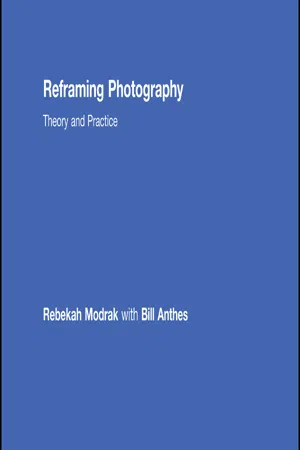
- 560 pages
- English
- ePUB (mobile friendly)
- Available on iOS & Android
About this book
To fully understand photography, it is essential to study both the theoretical and the technical.
In an accessible yet complex way, Rebekah Modrak and Bill Anthes explore photographic theory, history and technique to bring photographic education up-to-date with contemporary photographic practice. Reframing Photography is a broad and inclusive rethinking of photography that will inspire students to think about the medium across time periods, across traditional themes, and through varied materials. Intended for both beginners and advanced students, and for art and non-art majors, and practicing artists, Reframing Photography compellingly represents four concerns common to all photographic practice:
- vision
- light/shadow
- reproductive processes
- editing/ presentation/ evaluation.
Each part includes an extensive and thoughtful essay, providing a broad cultural context for each topic, alongside discussion of photographic examples. Essays introduce the work of artists who use a diverse range of subject matter and a variety of processes (straight photography, social documentary, digital, mixed media, conceptual work, etc.), examine artists' conceptual and technical choices, describe cultural implications and artistic influences, and analyze how these concerns interrelate. Following each essay, each part continues with a "how-to" section that describes a fascinating range of related photographic equipment, materials and methods through concise explanations and clear diagrams.
Key Features:
- case studies featuring profiles of contemporary and historical artists
- glossary definitions of critical and technical vocabulary to aid learning
- 'how to' sections provide students with illustrated, step by step guides to different photographic methods, alongside related theory
- fully up-to-date, with both high and low tech suggestions for activities
- online resources at: www.routledge.com/textbooks/reframingphotography will update information on equipment and provide further activities, information and links to related sites
- lavishly illustrated, with over 750 images, including artists' work and examples of photographic processes.
Frequently asked questions
- Essential is ideal for learners and professionals who enjoy exploring a wide range of subjects. Access the Essential Library with 800,000+ trusted titles and best-sellers across business, personal growth, and the humanities. Includes unlimited reading time and Standard Read Aloud voice.
- Complete: Perfect for advanced learners and researchers needing full, unrestricted access. Unlock 1.4M+ books across hundreds of subjects, including academic and specialized titles. The Complete Plan also includes advanced features like Premium Read Aloud and Research Assistant.
Please note we cannot support devices running on iOS 13 and Android 7 or earlier. Learn more about using the app.
Information
Part 1
Vision
INTRODUCTION
Theory 1
Theory: Seeing, Perceiving, and Mediating Vision
PHOTOGRAPHY AND THE ANATOMY OF SIGHT
calotype An early photographic process, made public by William Henry Fox Talbot in 1841. The process was the first negative–positive one in which endless reproductions could be made from an original negative. negative An image in which the tones are the opposite of those of the subject. In traditional photography, the image is on film. Light passes through the negative onto photographic printing paper to produce a positive print. The Pencil of Nature The title of William Henry Fox Talbot’s book, published in 1844 and the first to be illustrated with photographic prints tacked in place. Fox Talbot published the book in order to publicize the advantages of the calotype process and to inspire and instruct photographic hobbyists and budding professionals with a range of compositions and subjects. The term “the pencil of nature” references Fox Talbot’s belief in the objective nature of photography, in which the sun produced the images, not the artist. |
Table of contents
- Contents
- Figures
- Preface
- Acknowledgments
- Online Resources
- Part 1 Vision
- Part 2 Light and Shadow
- Part 3 Reproductive Processes
- Part 4 Editing, Presentation, and Evaluation
- Glossary
- Index